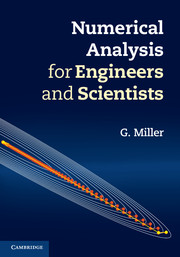Book contents
- Frontmatter
- Contents
- Preface
- 1 Numerical error
- 2 Direct solution of linear systems
- 3 Eigenvalues and eigenvectors
- 4 Iterative approaches for linear systems
- 5 Interpolation
- 6 Iterative methods and the roots of polynomials
- 7 Optimization
- 8 Data fitting
- 9 Integration
- 10 Ordinary differential equations
- 11 Introduction to stochastic ODEs
- 12 A big integrative example
- Appendix A Mathematical background
- Appendix B Sample codes
- Solutions
- References
- Index
1 - Numerical error
Published online by Cambridge University Press: 05 June 2014
- Frontmatter
- Contents
- Preface
- 1 Numerical error
- 2 Direct solution of linear systems
- 3 Eigenvalues and eigenvectors
- 4 Iterative approaches for linear systems
- 5 Interpolation
- 6 Iterative methods and the roots of polynomials
- 7 Optimization
- 8 Data fitting
- 9 Integration
- 10 Ordinary differential equations
- 11 Introduction to stochastic ODEs
- 12 A big integrative example
- Appendix A Mathematical background
- Appendix B Sample codes
- Solutions
- References
- Index
Summary
Types of error
The term “error” is going to appear throughout this book in different contexts. The varieties of error we will be concerned with are:
Experimental error. We may wish to calculate some function y(x1, …, xn), where the quantities xi are measured. Any such measurement has associated errors, and they will affect the accuracy of the calculated y.
Roundoff error. Even if x were measured exactly, odds are it cannot be represented exactly in a digital computer. Consider π, which cannot be represented exactly in decimal form. We can write π ≈ 3.1416, by rounding the exact number to fit 5 decimal figures. Some roundoff error occurs in almost every calculation with real numbers, and controlling how strongly it impacts the final result of a calculation is always an important numerical consideration.
Approximation error. Sometimes we want one thing but calculate another, intentionally, because the other is easier or has more favorable properties. For example, one might choose to represent a complicated function by its Taylor series. When substituting expressions that are not mathematically identical we introduce approximation error.
Experimental error is largely outside the scope of numerical treatment, and we'll assume here, with few exceptions, that it's just something we have to live with. Experimental error plays an important role in data fitting, which will be described at length in Chapter 8.
- Type
- Chapter
- Information
- Numerical Analysis for Engineers and Scientists , pp. 1 - 21Publisher: Cambridge University PressPrint publication year: 2014



